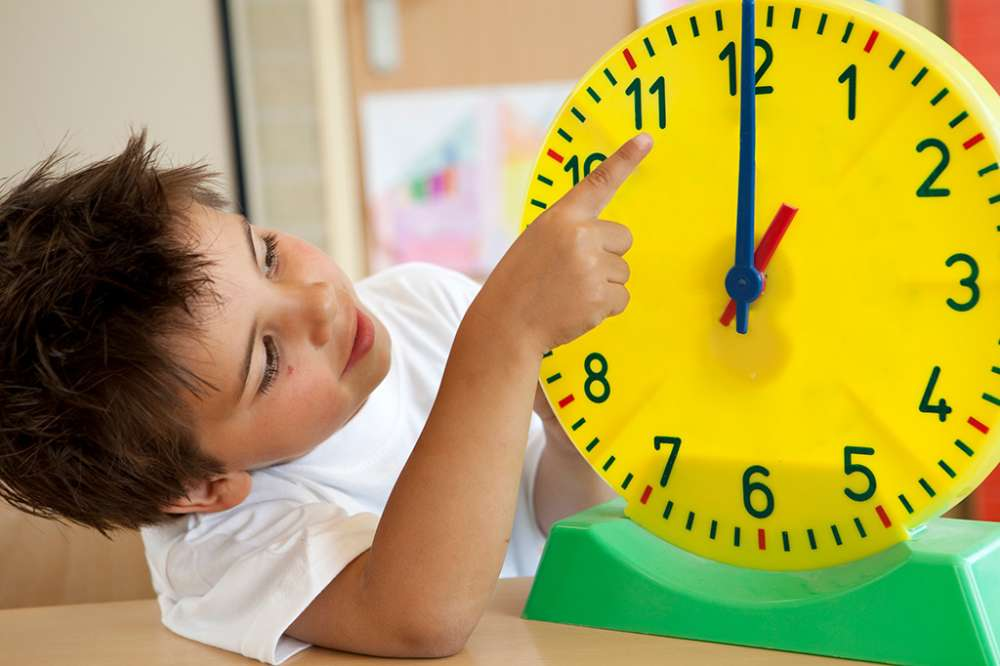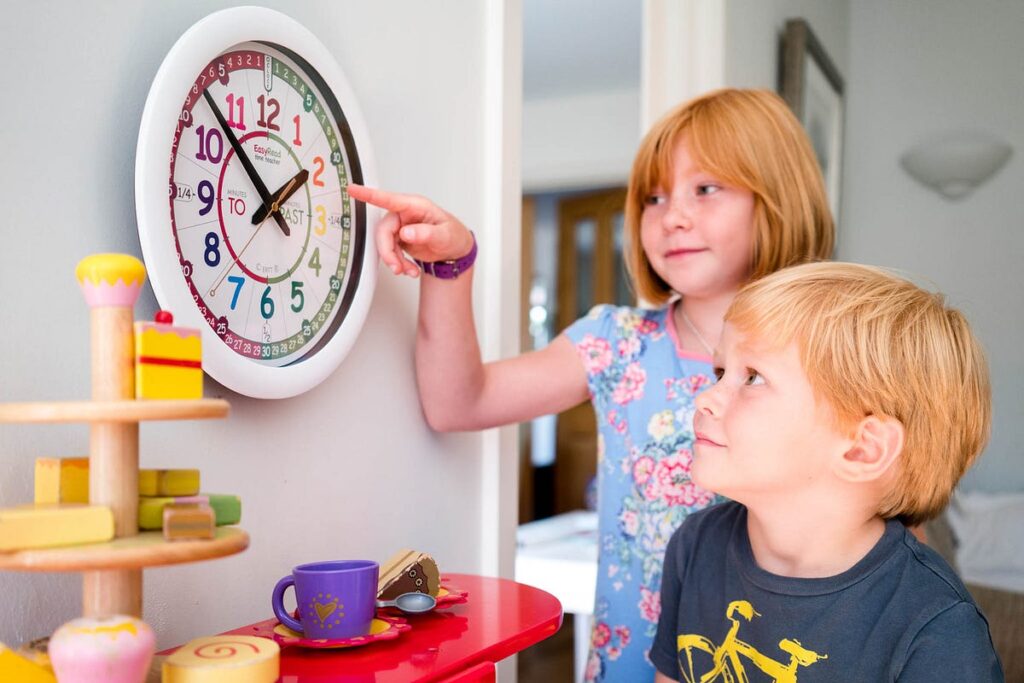https://mind.family/wp-content/uploads/2023/08/What-Is-Family-1.jpg
Is it just me or are kids having a hard time learning how to tell time? I’ve tried my best, but they still can’t get it right. But good news! Our guide will help you learn how to teach your child to tell time!
Telling time is a very important skill that is surprisingly hard to pick up. The tick-tock of the clock can be really confusing. That’s why we made this guide! By following along with us, we’ll turn their struggles into successes.
If your kid has been having a hard time learning how to tell time, then keep on reading because we’re about to enter a new chapter in their life!
Long-term Benefits of Teaching Kids How To Tell Time
Teaching your child how to tell time goes beyond just a practical life skill—it comes with a range of benefits that contribute to their overall development.

Here are some key advantages of teaching how to tell time:
1. Punctuality and Time Management:
Learning to tell time is the first step in understanding the importance of being on time. Good time management skills are valuable for life.
2. Routine and Predictability:
Knowing how to read a clock makes a child’s day easy to understand. They can anticipate activities and plan for them, which makes them feel safe.
3. Independence:
Kids can be more independent with their understanding of time. They can follow schedules, finish tasks, and make decisions based on how much time they have.
4. Mathematical Concepts:
When you tell time, you have to count sometimes. This means that kids will be doing addition, or maybe they’ll have to understand fractions (on an analog clock). Either way, this will help with their math skills.
5. Language Development:
Talking about time is also talking about “past” and “to.” Kids will become better at using these words when learning about time.
6. Responsibility and Accountability:
If a child knows what time it is, it’s easier for them to take responsibility for things they do or miss. It’ll also help them better manage their free time so they don’t miss anything important.
7. Social Skills:
Time lets you know when things are happening and when they’re supposed to end. If a child knows how long something takes and when it starts/ends, they’ll be able to make plans with others easily.
8. Cognitive Development:
Learning how to tell time isn’t as simple as you might think! It requires critical thinking skills for children to understand the abstract concept of numbers and exactly when events should take place.
In today’s world, kids also need to learn about digital clocks too! Learning both analog an digital clocks will help kids become better with other devices too!
Telling time is one of those skills that never stops being useful in life. It’ll always support success in school or at work!
Read More: What Is Permissive Parenting? 8 Benefits and Drawbacks
Step-by-Step Guide: How to Teach Your Child to Tell Time
Teaching your child to tell time can be an exciting and rewarding experience.

Below are some steps to guide them through this educational journey:
1. Start simple:
Begin with teaching the concept of time. Introduce it by talking about daily routines and activities your child does. Have them understand the order of events throughout their day.
2. Use a fun clock:
Get a colorful and engaging clock that has numbers that are clear to read. Make sure it represents something your child is interested in.
3. The parts of a clock:
Teach them the basics of how to tell time by introducing four components: face, hour hand, minute hand, and numbers.
Use very simple language to explain what they do as this will set the stage for a crucial lesson before moving on to reading time on an analog clock.
4. Practice counting:
Have them count upwards to sixty. Teach them how we count by fives for every minute (5, 10, 15, etc.).
5. Analog and digital:
Familiarize your child with both analog and digital clocks. Explain their differences, similarities, and how they each work.
6. Everyday activities:
Relate time-telling with everyday activities or events (i.e snack time or bedtime).
7. Clock games:
Play interactive games relating to the clock such as “What’s the Time, Mr.Wolf?”. You can even use a homemade one for hands-on learning!
8 . Create a schedule
Make a daily routine with specific times for every activity/event so your child can associate specific hours with certain things
9 . Repetition and reinforcement
Practice regularly and reinforce it through repetition! Keep it interesting by using different exercises/activities
Whenever they successfully accomplish something new make sure to acknowledge their achievement in order to boost their confidence!
Read More: Top 10 Fun Activities For Kids
How To Teach Telling Time On An Analog Clock?
Teaching time on an analog clock requires a bit more visual understanding.

Here’s how to teach your child to read an analog clock:
1. Start with the hour hand:
Teach your child that the short hand points to the hour. Practice counting by ones around the clock.
2. Introduce the minute hand:
Once your child understands hours, explain that the long hand shows minutes and moves “faster” around the hour hand.
3. Use visual cues:
Show your child labeled clock faces and drawings of where each hand should go. Point out what number each hand is pointing at.
3. Teach halves and quarters:
Move on to half-hour and quarter-hour increments and help your child learn how the minute hand relates to positions like 12, 3, 6, and 9.
4. Play “Move the Hands”:
Call out a time and have your child physically move the hands to match it. This hands-on approach reinforces their understanding.
5. Learn Roman numerals gradually:
If a clock has Roman numerals instead of normal numbers, start introducing them next to each other so your child can understand both systems at once.
Finally, read an analog clock together regularly — ask for a time check or have your child tell you the time at different points in the day — and they’ll learn in no time!
Read More: What Is Sleep Training: 5 Expert Tips To Help Regulate Your Child’s Sleep Pattern
How To Teach Telling Time On A Digital Clock?
Teaching your child to read a digital clock is much simpler.
Here are eight ways to teach them:
1. Make sure they understand the basics
You need to ensure your kid gets the concept of counting hours and minutes. Digital clocks display time in numerical form.
2. Help them identify hours and minutes
The numbers representing hours and minutes must be second nature for them. They should also recognize the colon as what separates the two.
3. Relate it to things they already know
Kids have a much easier time learning new things when they can relate it to what they already know. For example, saying “We have dinner at 6:30” or “Bedtime is at 8:00.”
4. Getting a large digital clock display helps
A big reason kids struggle with this is because they have bad eyesight and can’t see small digits that well yet. A larger display will make it easier for them.
5. Creating a digital schedule for them also works
Having a set routine is good for kids. It’s easy for them to learn because they know what’s coming next at all times. Using a digital clock to indicate when various activities occur makes this even better.
6. Play the “Set the Clock” game with them
This game involves you calling out specific times, and your child setting their digital clock accordingly. This makes learning fun since it’s more of an activity than just straight-up teaching time-telling skills.
7. Connecting both concepts also has its benefits
Relating analog time with digital time every now and then helps kids get that there’s a connection between the two. Show them how both formats look on their own, and how they work together.
8. Try using apps that teach time-telling skills
While some parents don’t like getting their kids started on electronics so early, others do since it’s a way better way of making learning more engaging.
Remember that being patient and practicing a lot is crucial. It’s also important to tailor your teaching style to your child and make it fun with games, activities, and real-life examples.
Read More: How To Teach Mindfulness To Kids: 12 Simple Ways
A Word From Mind Family
As we wrap up this ultimate guide on how to teach kids to tell time, we want to remind you of the awesome adventure that you’re about to go on with your little one.
Telling time isn’t just about the numbers and hands on a clock — it’s about teaching your child essential life skills. From learning how important it is to be on time to gaining crucial scheduling abilities, there are endless benefits.
So incorporate time-telling into your daily routines, play fun and engaging games, and enjoy every single smile that comes with understanding.
Now let’s gear up for the epic journey ahead by practicing patience, practice, and a touch of creativity!
Frequently Asked Questions (FAQs)
1. How to Teach Your Child to Tell Time?
Teaching time involves starting with basics, using engaging clocks, incorporating daily routines, playing games, and celebrating small successes. Make it a fun, interactive adventure!
2. How to Teach Telling Time on an Analog Clock?
Focus on hours, introduce the minute hand, use visual aids, practice half and quarter hours, play hands-on games, and gradually introduce Roman numerals for comprehensive analog clock learning.
3. How to Teach Telling Time on a Digital Clock?
Ensure a grasp of counting hours and minutes, identify digital digits, relate time to daily activities, use digital displays, create schedules, play interactive clock-setting games, and connect digital to analog concepts.
4. What Are the Benefits of Teaching How to Tell Time?
Benefits include instilling punctuality, time management, routine, independence, mathematical understanding, enhanced language skills, responsibility, improved social interactions, cognitive development, and relevance in the digital age.











